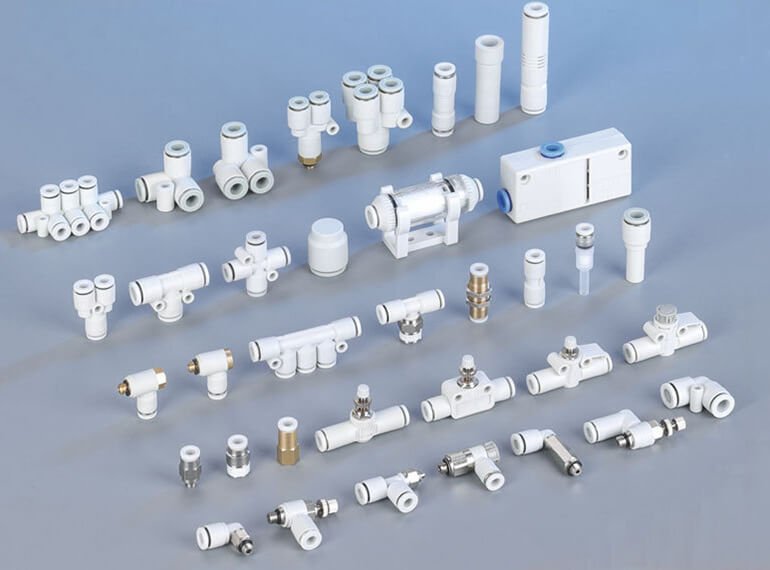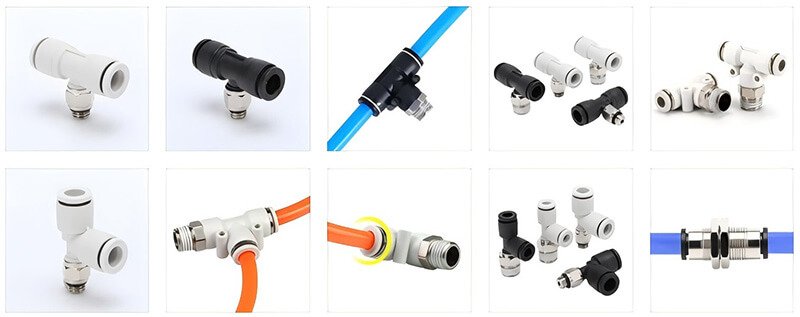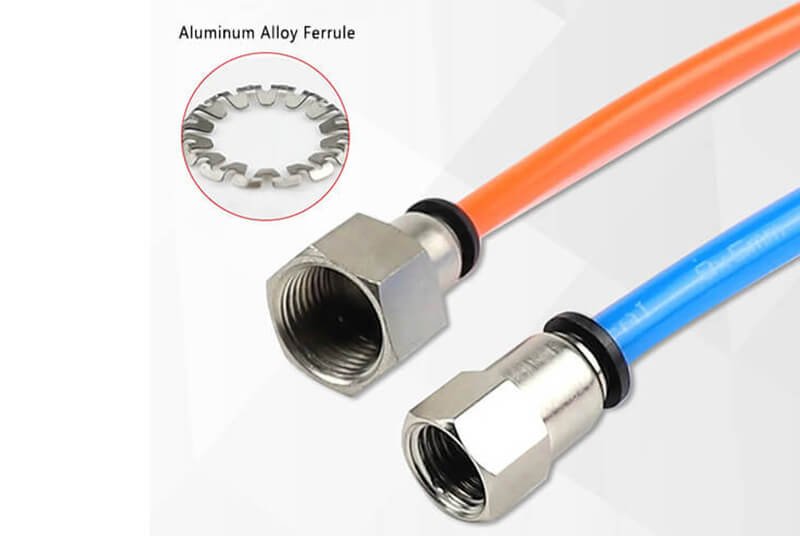Pneumatic systems play a crucial role in various industries, from manufacturing to automation. They rely on compressed air to power machinery and tools, offering advantages such as efficiency, precision, and reliability. However, to ensure that these systems work seamlessly, the components involved must be carefully chosen and properly connected.
A pneumatic system consists of several key components, each of which has a specific function that contributes to the overall operation. The three primary components we will discuss in this article are pneumatic valves, pneumatic fittings, and cylinder connections.
What are Pneumatic Valves?
Pneumatic valves control the flow of compressed air through a system. They regulate the direction, pressure, and speed of the airflow, ensuring that the system operates safely and efficiently. Valves are essential for directing air to specific parts of a machine or system, controlling the movement of pneumatic cylinders or actuators.
What are Pneumatic Fittings?
Pneumatic fittings are used to connect various components within a pneumatic system, such as tubes, hoses, and valves. Their primary role is to securely attach these parts, ensuring that the system remains leak-proof and functions as intended. Fittings come in a variety of types, including push-to-connect, threaded, and quick-connect options, each suited for specific applications.
What are Cylinder Connections?
Pneumatic cylinders are the components that convert compressed air into mechanical movement, driving the motion of machinery and tools. Cylinder connections are the links that attach the cylinders to other components in the system. These connections are crucial for ensuring that the cylinder operates correctly, with options including threaded and flanged connections.
Together, valves, fittings, and cylinder connections form the backbone of any pneumatic system. When these components are properly chosen and installed, they allow for smooth and efficient operation, contributing to the reliability and safety of the system.
Pneumatic Valves
Pneumatic valves are essential components in any pneumatic system. They control the direction, flow, and pressure of compressed air to ensure the system functions efficiently and safely.
Function of Pneumatic Valves
The primary function of a pneumatic valve is to regulate the airflow within the system. These valves control when and how air enters or exits different components, including cylinders, actuators, and tools. By directing the flow of air, they enable various operations such as extending or retracting a cylinder or activating a tool.
In addition to controlling flow, valves also help control pressure to prevent damage to the system from excessive air pressure. Some valves even regulate the speed of the airflow to manage how quickly a system or component operates.
Types of Pneumatic Valves
There are several types of pneumatic valves, each designed for a specific function. Here are the most common ones:
- Directional Control Valves: These valves control the direction of airflow within the system. They are typically used to change the path of the air, allowing it to flow to different components as needed.
- Pressure Relief Valves: These valves protect the system by releasing excess pressure when it exceeds a preset limit. This ensures that the system operates within safe pressure ranges.
- Flow Control Valves: As the name suggests, these valves regulate the flow rate of compressed air. They help control the speed of actuators and cylinders by adjusting the amount of air entering or leaving the component.
Choosing the Right Pneumatic Valve
Selecting the correct valve is crucial for the performance of your system. When choosing a valve, consider the following:
- Application Requirements: What is the valve’s purpose in the system? Does it need to control pressure, flow, or direction?
- Pressure and Flow Rate: Ensure the valve is suitable for the system’s pressure and flow requirements.
- Size: The valve should be compatible with the pipe or tubing size in the system.
- Material: Select valves made from durable materials that can withstand the pressures and conditions of the specific application.
Pneumatic Fittings
Pneumatic fittings are used to connect various components within a pneumatic system, ensuring a secure, leak-proof connection. They play a vital role in directing the flow of air and preventing air loss.
Role of Pneumatic Fittings
Fittings are essential for connecting components such as hoses, valves, and cylinders. They ensure the system remains sealed and efficient, preventing air from leaking out and ensuring that the compressed air flows exactly where it is needed.
Without the right fittings, even the most well-designed pneumatic system could experience pressure drops or air loss, reducing the system’s efficiency and increasing energy consumption.
Types of Pneumatic Fittings
There are different types of fittings, each designed for specific applications. Some of the most common types include:
- Push-to-Connect Fittings: These fittings are easy to install and remove without the need for tools. They are widely used in systems where quick connections and disconnections are required.
- Threaded Fittings: Threaded fittings screw into the ports of valves or cylinders, providing a strong, secure connection. They are ideal for high-pressure applications.
- Quick-Connect Fittings: These fittings allow for fast and easy connections and disconnections, often used in applications that require frequent maintenance or changes to the system.
Choosing the Right Pneumatic Fitting
When selecting pneumatic fittings, consider the following factors:
- Compatibility: Ensure the fitting matches the size and type of the components being connected.
- Material: Choose fittings made from materials suitable for the operating environment, such as stainless steel for high-pressure or corrosive environments.
- Application Type: Different fittings are suited for various types of systems, whether they are for low-pressure or high-pressure environments.
Cylinder Connections
Pneumatic cylinders convert compressed air into mechanical motion, powering equipment and machinery in many applications. Proper cylinder connections are crucial for ensuring that the cylinders operate safely and efficiently.
Role of Cylinder Connections
Cylinder connections are the interfaces that link a pneumatic cylinder to the rest of the system. These connections ensure that compressed air flows into and out of the cylinder, allowing it to extend or retract and perform its intended functions. Without secure and correctly sized cylinder connections, the cylinder might not operate correctly, leading to inefficient or unsafe operation.
Types of Cylinder Connections
There are several methods for connecting cylinders to a pneumatic system, depending on the application:
- Threaded Connections: These are the most common type of cylinder connection. They involve screwing the cylinder into a threaded port, ensuring a strong and leak-proof seal.
- Flange Connections: Flanged connections are often used for larger cylinders. They involve attaching a flange to the cylinder and bolting it to the mounting surface, ensuring a secure connection.
- Quick-Release Connections: For applications that require fast disconnection and reconnection, quick-release connectors are used. These allow for easy maintenance and adjustment of the system without interrupting the air supply.
Best Practices for Cylinder Connections
To ensure optimal performance of your pneumatic cylinders, follow these guidelines:
- Ensure Tight Seals: Make sure all connections are secure and free of air leaks. Leaks can lead to reduced efficiency and increased operational costs.
- Check Size Compatibility: Always choose the correct size fittings and connections to ensure a smooth flow of air and avoid pressure drops.
- Use Durable Materials: Ensure that the cylinder connections are made from materials that can withstand the pressure and conditions of your specific application.

Integration of Valves, Fittings, and Cylinders
In a pneumatic system, the integration of valves, fittings, and cylinders is essential for smooth and efficient operation. These components must work together seamlessly to control the flow of air, regulate pressure, and facilitate movement. A well-integrated system ensures that compressed air is directed where it is needed and at the correct pressure, resulting in efficient and safe operation.
How Valves, Fittings, and Cylinders Work Together
- Valves: Valves are responsible for directing the flow of air to different parts of the system. They control when and where the air goes, ensuring that it reaches the cylinder or actuator at the right time.
- Fittings: Fittings ensure that the components, including valves and cylinders, are properly connected and sealed. They prevent leaks and ensure the system maintains the necessary pressure for operation.
- Cylinders: Pneumatic cylinders convert compressed air into mechanical motion. The correct amount of air must be directed into the cylinder at the right time to achieve the desired movement or force.
When these components work in harmony, the pneumatic system can operate smoothly, with minimal downtime and optimal efficiency. For example, in an automated assembly line, valves control the timing of air flow, fittings securely connect various system parts, and cylinders perform the precise movements required for the task.
Common Applications of Integrated Systems
Integrated valve, fitting, and cylinder systems are used in a wide range of applications:
- Industrial automation: Pneumatic systems control the movement of robotic arms, conveyors, and other automated machinery.
- Material handling: Pneumatic cylinders drive equipment that moves and positions materials in factories or warehouses.
- Machine tools: Valves and cylinders work together to control the movement of machine parts, enabling precise machining operations.

Maintenance and Troubleshooting
To ensure the longevity and optimal performance of a pneumatic system, regular maintenance and troubleshooting are necessary. Proper maintenance can help prevent downtime and costly repairs, while troubleshooting allows for quick resolution of issues when they arise.
Routine Maintenance Tips
Here are some key maintenance practices for pneumatic valves, fittings, and cylinders:
- Inspect for Leaks: Regularly check all fittings, valves, and cylinder connections for any signs of air leaks. Leaks can lead to inefficiency and increased operational costs. Use a soapy water solution to detect small leaks in the system.
- Clean Components: Dust and debris can accumulate in pneumatic components, affecting their performance. Clean the valves and fittings regularly to ensure smooth airflow and prevent blockages.
- Lubricate Moving Parts: Ensure that any moving parts in valves and cylinders are properly lubricated. This reduces wear and tear, preventing breakdowns.
- Check Pressure Levels: Monitor the system’s air pressure regularly to ensure that it stays within the recommended range. Over-pressurization or under-pressurization can cause damage to components.
Troubleshooting Common Issues
When problems arise in a pneumatic system, quick troubleshooting is necessary to minimize downtime. Here are some common issues and their potential causes:
- Air Leaks: Leaks are a common problem and can occur at fittings, valve seals, or cylinder connections. Ensure all components are tightly connected and replace any worn seals or damaged parts.
- Inconsistent Airflow: If airflow is inconsistent, check for blockages in the valves or fittings. A clogged valve or air line can restrict airflow, causing poor system performance.
- Cylinder Malfunctions: If a cylinder is not moving as expected, check the pressure and flow control valves. An issue with either can prevent the cylinder from extending or retracting correctly.
- Excessive Noise or Vibration: This could indicate an issue with the valve or fitting, such as air cavitation or loose components. Inspect the system and tighten any loose connections.
Conclusion
Understanding the roles and functions of pneumatic valves, fittings, and cylinders is crucial for designing, operating, and maintaining efficient pneumatic systems. These components work together to control the flow of air, regulate pressure, and generate mechanical motion, enabling the wide variety of applications that pneumatic systems support.
By selecting the right components, ensuring proper integration, and performing regular maintenance, you can create a reliable and long-lasting pneumatic system. Additionally, being proactive in troubleshooting and addressing issues as they arise will keep the system running at peak performance, preventing costly downtime and improving overall efficiency.



One Response
This writing has a deep, soothing quality to it — like the feeling of watching a sunset and finding peace in the quiet.